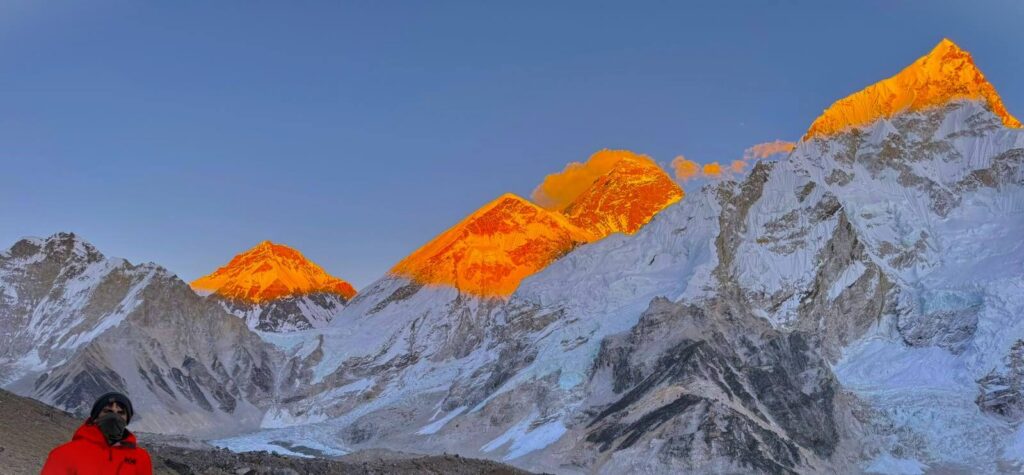
Trekking to the Everest Base Camp is a unique expedition that many adventurers dream about to reach at the foot of the top most peak on earth. Yet getting to Everest is not without its challenges, and the difference between a dream trek and a nightmare often boils down to the experience of your guides — the Sherpas, in particular. Sherpas are indigenous people who live in the Khumbu region of Nepal, and they are integral to making the Everest Base Camp trek both safe and remarkable. Their experience locals knowledge and incredible support on the journey make every mile possible, turning a physically challenging trek into an unforgettable adventure.
Sherpas are the locals who specialize in navigating the rugged, high-altitude terrain of Everest’s surroundings. They were born and grew up in the shadow of the Himalayas and know the land and conditions intimately. Their knowledge of the trekking paths, the best spots to stop for rest, and the safest ways to travel, makes them incredibly valuable companions. While trekkers work their way through the extreme and sometimes unpredictable conditions, Sherpas make surethey stay on course, helping avoid potentially deadly situations like rockslides or rogue patches of ice. Their sharp navigational instincts and mountain experience can guide trekkers to concentrate on the experience itself, rather than dangers that may lie ahead.
In addition to their role as navigators, Everest Trekking Sherpas are critical in addressing the physiological challenges associated with high-altitude trekking. The Everest Base Camp trek ascends above 5,300 meters (17,400 feet) where the air is thinner, oxygen levels are lower, and altitude sickness is a real threat. Sherpas are specially adapted to these high altitudes, and are familiar with the slow process of acclimatization. They also help trekkers keep pace, take proper breaks, and avoid overexertion, which is important for avoiding altitude-related illnesses. 1. Sherpas are trained to recognize early altitude sickness symptoms and can advise or take trekkers for medical help if required, ensuring safety throughout the journey.
The most extraordinary aspect of trekking with Sherpas is the cultural connection. The Sherpas’ connection to the mountains is imbued with spiritual meaning. Everest — Sagarmatha in Nepali — is not only a mountain for them; it is sacred. As you venture along, Sherpas reveal their rich culture, Buddhist religion, sacred monasteries, and way of life. This aspect of cultural engagement adds an additional layer of meaning and significance to the trek, as it becomes more than just a physical challenge — it is a spiritual and cultural journey. Their stories of their mountains, their families and their way of life give trekkers an intimate sense of the land they walk.
Additionally, Sherpas offer vital emotional support on the trek. Trekking to Everest Base Camp is physically taxing, and many trekkers will encounter periods of fatigue, self-doubt, or homesickness. Besides their dogged positivity and real concern for trekkers’ well-being, sherpas provide encouragement, humor, emotional support when the going gets tough. They become trusted partners in challenge, helping trekkers grind through difficult days with a friendly smile and an encouraging word, forming bonds that endure long after the trek is complete.
When you trek to Everest Base Camp with Sherpas, the climb goes beyond the summit. This not only becomes one of exploration, relationship and self development, but with the legend knowledge and culture, perseverance and hospitality of the Sherpas, it makes the expedition even more powerful. With their role in keeping trekkers safe, enriching the cultural experience, and even providing emotional support, the trek is about more than the physical achievement — it’s a transformative experience. The Sherpas really make the Everest Base Camp trek a truly epic journey of a lifetime, or an adventure of a lifetime, not just a mountain trek.
Everest Base Camp Trek: The Adventure of a Lifetime!
One of the most popular and breathtaking treks in the world is the 14 Days Everest Base Camp trek. The trek takes place at the base of the tallest mountain in the world, Mount Everest, and allows trekkers to experience some of the most spectacular scenery in the world. The road to Everest Base Camp, from verdant valleys and terraced fields to breathtaking mountain views and centuries-old monasteries, is as much the journey as the destination. For many, the hike is a dream that lasts a lifetime, an opportunity to stand in the shadow of a mountain that has beckoned the hearts of adventurers for centuries. Trekkers also must contend with the rugged nature of the terrain, high altitude, changing weather and the physical impact the trail takes on their bodies. This is the true magic of the trek: the companionship of Sherpas who make ascent not only possible but exceptional. They use their knowledge, guidance, and support to ensure that this excruciating trek becomes an unforgettable and rewarding journey making Everest Base Camp accessible and enriching for the trekkers of every background.
What is the Role of Sherpas in Your Trekking Adventure
The Sherpas, an ethnic group native to the Khumbu region of Nepal, are indispensable in taming the Everest Base Camp trek, ensuring that it is safe, enjoyable and enriching in every sense of the word. For decades, the Sherpa have been guide on the Himalayas for mountaineers and trekkers. And Sherpas are not just guides—they are the lifeblood of the Everest trek. Their intimate understanding of the region’s geography, weather patterns and cultural heritage makes them invaluable companions on this journey. They’re with you every step of the way, from offering advice on the best paths to take to telling tales about the mountains and their local customs. Sherpas perform logistical, from carrying heavy loads to pitching a tent, while ensuring trekkers’ safety and comfort. For many trekkers the hospitality, warmth, and humor of the Sherpas are among the most beloved aspects of the trip, forging lasting friendships that make this experience far more than a simple physical challenge.
Sherpas as Expert Guides: On their Journey
The trail to Everest Base Camp is rugged and takes multiple days with different terrains, from grassland and suspension bridges to rock paths and high mountain passes. A Sherpa guide is indispensable, as their familiarity with the route simplifies the navigation process. Sherpas are expert route finders who know every bend, incline and risk on the path. Their intimate knowledge of the land allows them to guide trekkers safely away from the potential dangers they may encounter along the way—from avalanches to rockslides—things that are frequently encountered in the Everest region. They also know where to rest and eat, to make sure that trekkers are fed and comfortable on their journey. Their support goes beyond just showing the way; they help trekkers judge their speed, nudging them to pause for breath in addition to the rest stops, `and they provide cultural context for all the dumb of breath shattering the Mount Everest region, such as monasteries and stupas. In fact, with Sherpas at the helm, trekkers can confidently brave the great Everest region without the headache of determining the labyrinth of routes themselves, making the experience vastly more pleasurable.
The Role of Sherpas in Your Trek Safety
It is a strenuous and hazardous journey, mainly due to the challenging environment they travel through: Everest Base Camp the elevation, extreme weather, and rough terrain. Sherpas are trained to prioritize safety at every step of the trek. Trek leaders are experts in the field and their extensive mountain knowledge and many years of experience will make sure trekkers are high up and well used to the challenges ahead, point out. Sherpas are also there to help moderate the pace of the trek to reduce the risk of altitude sickness, a potentially serious condition that can develop at high altitudes. They keep a close eye on trekkers’ physical conditions and modify the trip as necessary to prevent overexertion. Plus, Sherpas transport crucial gear, such as first aid kits, and have extensive training in dealing with emergencies, so you can relax, knowing they could respond in a health situation. If any situation does occur, sherpas can take on the responsibility of making crucial decisions, whether it involves a decision to alternate the path or provide medical help or evacuation service if needed. With experience on adverse weather, traversing perilous parts, and ensuring that trekkers have the correct gear for the adventure, Sherpas are a vital part of keeping the trek efficient and safe.
Idealistic Acclimatization: The Wisdom of The Sherpas in High Altitude Management
Acclimatization is one of the most important things on the Everest Base Camp trek; trekkers will need to initially adjust to high elevation (the air has lower oxygen levels) where few to no living organisms, including humans, can survive. The hike climbs to more than 5,300 meters, which can lead to altitude sickness if trekkers fail to acclimatize properly. Sherpas also play a critical role in acclimatization management. Sherpas who are born and raised at high altitudes are biologically adapted to thin air, and have an innate understanding of how the body responds to altitude change. They know the gradual acclimatization process well, which requires resting at intermediate altitudes to adjust the body. Sherpas also ensure the group has enough rest days and that pace is slow and deliberate, mitigating the risk of altitude sickness. They also make recommendations for hydration, nutrition, and signs and symptoms of altitude-related illnesses, to help ensure that trekkers stay in tip-top shape. Sherpas are responsible for providing guidance on how to deal with the high altitude trek and makes it an easier experience because of their previous knowledge.
Cultural Insights: Immersing In Sherpa Life
Everest Base Camp trek is not only an adventure through dramatic scenery but it is also a journey into the soul of the Sherpa Culture. The Sherpas are a culturally rich ethnic group who have been settled in the Khumbu region of Nepal and their traditions, spirituality and lifestyle play a vital role in any Everest experience. Sherpas provide insight into their rich cultural heritage along the trek, giving trekkers a glimpse into the customs, rituals and beliefs of the Sherpa people. While trekkers move through small villages, Sherpas might stop to point out the significance of Buddhist monasteries, prayer flags and stupas that dot the trail. They might share tales of their forefathers and the history of the area, much of it dripping with spirituality and respect for the mountains. The sacredness of Everest, called Sagarmatha in Nepali, is core to Sherpa culture, and respect for the spiritual nature of the mountain is handed down from generation to generation among the Sherpa. Connecting with the Sherpas, trekkers learn more about the local culture of the area, thus the trek becomes a physical challenge mixed with cultural exploration as well.
Sherpas as the Emotional Support System
Going to Everest Go at Night: This trail is one of the physically challenging treks that can be overwhelming sometimes. Considering tiredness, height sickness or long journey mental stress, most trekkers look for emotional support. Sherpas are not merely guides and porters; they are the wind beneath our wings, constantly encouraging during those moments that get tough. Reflective of their title, their positive attitude, resilience and unwavering support carry trekkers through the challenges of the journey. Sherpas frequently speak words of encouragement, puncturing the tension with humor and banter. Their intimate bond with the mountains and their recognition of both the physical and emotional stress trekkers experience make them ideal company. They know when to prod trekkers through and when to call for rest. For many trekkers, the connection with their Sherpa guide extends beyond their professional relationship to become a lifelong friendship based on trust, support, and mutual respect. This emotional bond is the most loved of the whole Everest trek, from a physically demanding adventure to one you never forget.
Knowledge of the Terrain Improving Local Knowledge
The Everest Base Camp trek covers a wide variety of scenery, including dense forests, green valleys, barren rocky terrain, and high-altitude glaciers. Conditions at high altitudes can change on a dime, and the weather is no less unpredictable. Sherpas are local experts who have a good understanding of the terrain and weather patterns. They understand the best trails this way, which roads are safer and how to avoid seeing danger hidden by beauties like avalanche or landslide that can be found in places. Sherpas are also vigilant about the weather, which can change rapidly, particularly at higher elevations. Their understanding of the region’s microclimates helps prepare trekkers for changing conditions and make sure they are appropriately dressed and equipped. When the weather changes suddenly, whether snowstorms or heavy rain, Sherpas know when to alter plans, seek shelter or guide the group along different routes. Their in-depth local knowledge keeps travelers safe, comfortable, and on course, making for a much less stressful and more enjoyable trek.
Environmental responsibility in Sherpas andನೆ
It is not just a profession for Everest Base Camp Gear Sherpas who guide trekker in the rough hewn terrain of the Everest region, but also a dedication to protect one of the environment that sustains their way of life. Over the years, the effects of tourism on the Everest region have become more pronounced, as large numbers of trekkers visit each year, raising concerns about waste, pollution, and the degradation of natural resources. As guides and porters, the Sherpas help to spread awareness of issues around environmental responsibility and sustainable practices, when trekking. Several Sherpa-led companies are engaged in such efforts to clean the environment, organizing clean-up drives or urging trekkers to minimize their carbon footprint. They also encourage respect for nature, saying take only photos and leave only footprints. Sherpas also serve as advocates for responsible tourism, making sure that trekkers are aware of the effect of their visit on the local landscape, and people, surrounding the industry. The ethos of eco-tourism ensures that future generations visiting the Everest region can still experience and enjoy its beauty, while maintaining the region’s delicate ecosystems for years to come.
An Experience Trekker Sherpa Bond To Create Unique
This relationship between a trekker and a Sherpa is unique, rooted in trust, respect and experiences shared. Sherpas are more than guides or porters; they are companions, mentors, and friends on the journey. The bond formed during the trek is unique, As trekkers rely on their Sherpas for support, advice and encouragement throughout the painstaking and grueling journey up to Everest Base Camp. Sherpas care deeply about the safety and comfort of the trekkers and it is very reassuring to us that they are always around. In addition to exploring breathtaking landscapes, trekking with a Sherpause provides the opportunity for trekkers to learn about the Sherpa culture, including their traditions and relationship with the mountains, which leads to an enriching exchange of culture that is above and beyond the typical tourist experience. Most trekkers depart with their hearts full of gratitude to their Sherpas, though they helped achieve the goal, they also shared the joy and sense of accomplishment. The bond that forms along the trek often outlasts the journey itself: Many trekkers stay in contact with their Sherpas and return to Nepal to trek again. It is said that the relationship between a trekker and a Sherpa is the most significant element of the Everest Base Camp journey; a journey of personal development, shared experiences, and lasting friendships.
Sherpas’ Problem-Solving Skills: Overcoming Challenges
There’s always the unexpected on the Everest Base Camp Trek that can challenge even the most prepared trekkers. Sudden changes in the weather, physical exhaustion, all of these require quick thinking and ability to adapt. With their knowledge of the region and decades of experience, Sherpas have remarkable problem-solving skills that help get past these challenges. Whether it’s changing the route because of bad weather, helping someone with a medical situation or leading a group through challenging terrain, Sherpas always have a plan of action.” The experience and knowledge of young people working in the mountains, and their ability to quickly navigate unexpected changes allows trekkers to resume their expedition in safety. Such expertise allows trekkers to experience challenges with confidence, because their Sherpa guides possess the skills and wisdom to find a way through.
The Journey: How Sherpas Carry Loads You Can’t
For a successful Everest Base Camp trek, one of the keys is to have the right gear for your journey. The rugged terrain and high altitude require specialized gear and equipment along with extreme weather conditions. But the Sherpas also help prepare trekkers for a successful journey by providing counsel on what to bring, and Pagano says they will ensure all necessary equipment gets packed for the trip. They also know the specific clothing, footwear and gear needed for the trek, and how to advise you based on the unique conditions of the Everest region. And Sherpas do much more than just guide trekkers — many help trekkers carry heavy loads up mountains, ensuring the weight is evenly distributed and that trekkers do not carry what they don’t need. Sherpas are well versed in making gear corrections on the move, be it adjusting trekking boots or ensuring backpacks sit comfortably. It helps trekkers to feel safe that they have the appropriate gear to face the difficulties of the trek.
Sherpas: The Unsung Heroes Behind Every Successful Trek
The crew behind a trek to Everest Base Camp often makes the difference, and that crew is made up of experts known as Sherpas. They are the backbone of the journey, navigating trekkers through treacherous terrain, managing the physical challenges of high-altitude hiking, and keeping everyone safe at each turn. These professionals have extensive training on acclimatization, navigation, and emergency procedures, which has greatly lowered the dangers of hiking at these heights. Thanks to their assistance, trekkers are prepared to better handle physical stressors associated with the trek like altitude sickness and fatigue by ensuring a suitable pace is kept and rest is had as needed. Plus, Sherpas’ expertise helps trekkers better appreciate both the region’s culture and its natural beauty, transforming what could be a grueling effort into an enriching, memorable adventure. They are much more than guides, as they make the difference between being able to complete the trek or not, which is why trekkers not only reach Everest Base Camp but also do so safely and with a greater insight into the Himalayas.
Trekking for the Benefit of the Sherpa Community
Shot Trekking to Everest Base Camp is not just a pursuit of personal goals, but it also contributes greatly to the livelihood of the Sherpa community. Sherpas have been guiding trekkers and climbers for decades, and the income from trekking services plays a crucial role in the local economy, providing employment and supporting families in the Khumbu area. trekkers are able to spend a day with Sherpas who are hired as guides, ensuring that the community is sustainable, supporting and funding education, healthcare or infrastructure projects. Many Sherpas also run tea houses, trekking agencies, and other businesses to help support their families and communities. By supporting Sherpa-led trekking companies, you are ensuring that the wealth generated by all the tourist dollars spent trickles down to the local community, directly benefitting the people who, quite literally, make the Everest Base Camp trek a reality. Such relationships promote mutual respect and a sense of shared responsibility between trekkers and the Sherpas, demonstrating the need for ethical and responsible tourism.
Sherpas and Their Stories: Persuading Visitors to Respect the Experience
It is one the most rewarding part of doing a trek with Sherpas, listening to their life stories and getting a glimpse of their life. For generations, Sherpas have lived in the shadows of Everest, and their stories, both on the mountain and in the surrounding communities, provide trekkers with a perspective on life in the Himalayas that’s second to none. Along the way, Sherpas often tell their own life stories, stories of legendary ascents, and the trials they’ve endured within the mountains. These tales offer trekkers insight into Sherpa culture, as well as the role the mountains play in their lives. The wisdom of the Sherpas, learned over generations, has much to teach us about resilience, humility before nature and powerful community bonds. It is another thing for you yourself to read their words of encouragement, but also combine your experiences with practical knowledge of the goal and gradually break down the folklore behind it, turning the journey into two things, as a warm physical journey and a journey of spirit.
Conclusion: Why the Sherpa Make the Everest Base Camp Trek Special
It’s an adventure of a lifetime to trek to Everest Base Camp, but it’s the Sherpas who make it absolutely exceptional. Their invaluable guidance, expertise and deep cultural knowledge ensure that trekkers not only remain safe and find success but also, in doing so, make the trek a rich, immersive experience. Sherpas aren’t just guides — they’re companions, teachers and guardians who help trekkers solve problems, learn about the land and culture and strive to achieve their goals. Their dedication to safety, their problem-solving skills, their willingness to offer emotional support — they make the trek possible and purposeful. Moreover, the monetary assistance trekkers offer to the Sherpa people fosters a sustainable relationship between visitors and local residents who consider the Everest region home. So, while trekking to Everest base camp with sherpas offers an unforgettable physical adventure it is also your ticket to get a better emotional and cultural experience of the majestic beauty and nature both the mountains endorse, ensuring that this trip will always stay with you for a lifetime.





